AccessSTEM Capacity Building Institute (2009)
April 27, 2009
Seattle, Washington
The goal of the 2009 AccessSTEM Capacity-Building Institute (CBI) was to share AccessSTEM project objectives and progress and to brainstorm ideas for future collaborations and activities. Broad issue areas discussed included barriers to STEM for students with disabilities, lessons learned in previous DO-IT projects, and results from DO-IT's longitudinal transition study (ALTS).
The AccessSTEM CBI began with presentations about the AccessSTEM project by project leadership and NSF staff. Following these presentations, small groups worked to brainstorm solutions for increasing participation of students with disabilities in science, technology, engineering, and mathematics fields.
AccessSTEM Capacity Building outcomes benefit society by making STEM opportunities available to more citizens and enhancing STEM fields with the perspectives of people with disabilities.
Introduction
A series of activities were undertaken to understand the underrepresentation of people with disabilities in science, technology, engineering, and mathematics (STEM) careers and increase their participation in these fields. These activities were funded by the Research in Disabilities Education (RDE) program of the National Science Foundation (NSF). They were coordinated by the Alliance for Students with Disabilities in Science, Technology, Engineering, and Mathematics (AccessSTEM), which is directed by Sheryl Burgstahler.
Capacity Building Activities
AccessSTEM collaborated with key stakeholders to:
- conduct a Capacity-Building Institute (CBI) in April 2009
- share results of the CBI with NSF projects and other stakeholders
- provide an electronic forum to continue discussion of accessibility issues and provide support for accessibility efforts
- extend resources to other programs and promising practices via an online searchable Knowledge Base
AccessSTEM is a project of the DO-IT Center (Disabilities, Opportunities, Internetworking, and Technology) at the University of Washington in Seattle. AccessSTEM serves to broaden participation in STEM fields through the inclusion of individuals with disabilities.
Goal and Outcomes
All of these activities support an NSF goal: "Working to broaden participation in science and engineering reinforces NSF's mandate to fund the best ideas from the most capable researchers and educators, now and in the future" (Investing in America's Future: Strategic Plan FY 2006–2011, NSF, www.nsf.gov/publications/pub_summ.jsp?ods_key=nsf0648, p. 3). AccessSTEM CBI outcomes benefit society by making STEM opportunities available to more citizens and enhancing STEM fields with the perspectives of people with disabilities.
Audiences for These Materials
This publication was created for people who:
- participated in the 2009 AccessSTEM Capacity-Building Institute
- want to conduct their own Capacity-Building Institute at their institution, in their region, or in a nationwide or international forum. seek to increase their understanding of issues surrounding the underrepresentation and participation of individuals with disabilities in STEM studies and careers
- are motivated to join an electronic community to continue discussion of these issues
- are NSF project directors and program officers interested in increasing the participation of people with disabilities in all NSF projects
- would like to get connected to resources to help them make their project resources and activities accessible to people with disabilities
- have promising practices to share with others.
About the CBI
The AccessSTEM Capacity Building Institute (CBI) took place April 27, 2009, in Seattle. Its overall purpose was to explore ways to increase the participation of people with disabilities in all science, technology, engineering, and mathematics (STEM) projects, academic programs, and, ultimately, careers. A particular focus was on potential interventions for high schools, community colleges, and two-year schools in and near Seattle.
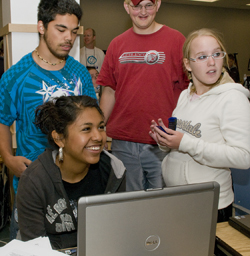
Participants in this half-day event included AccessSTEM project leadership and key staff, core stakeholder groups, and representatives from NSF. Hosted at the University of Washington, the AccessSTEM CBI provided a forum for sharing successful practices, reporting research results, developing collaborations, and otherwise increasing the capacity of all NSF-funded projects to serve individuals with disabilities.
The goal of the AccessSTEM CBI was to share AccessSTEM project objectives and progress and to brainstorm ideas for future collaborations and activities. Broad issue areas discussed included:
- barriers to STEM for students with disabilities
- lessons learned in previous DO-IT (Disabilities, Opportunities, Internetworking, and Technology) projects
- results from DO-IT's longitudinal transition study (ALTS)
In this CBI:
- All participants were actively engaged.
- Participants didn't just present predetermined professional development content; they requested and offered content as the meeting evolved.
- Participants explored ways to build capacity to reach the goal of the Institute, within their project organizations and beyond.
The AccessSTEM CBI began with presentations about the AccessSTEM project by project leadership and NSF staff. Following these presentations, small groups worked to answer the following question:
- What are specific things that project partners (Seattle Public Schools, Seattle Community Colleges, Bellevue College, and University of Washington) can do in 2009–2010 to increase the participation of students with disabilities in science, technology, engineering, and mathematics?
Group representatives reported to all participants and notes were incorporated into the proceedings. The results of these efforts are shared online at Event Proceedings.
Agenda
8:00 - 8:30 a.m.
Registration, Networking, and Continental Breakfast
8:30 - 9:00 a.m.
Welcome and Opening Remarks
- Sheila Lange, Vice President Minority Affairs/Vice Provost Diversity, Office of Minority Affairs, University of Washington
- Matt O'Donnell, Dean, Engineering and Bioengineering, University of Washington
- Mark Leddy, Program Director, RDE, NSF
9:00 - 10:00 a.m.
Overview of AccessSTEM Project
- Mari Ostendorf, Professor, Electrical Engineering, University of Washington
- Sheryl Burgstahler, Director, Accessible Technology and DO-IT, UW Technology
10:00 - 10:05 a.m.
Small Group Discussion Introduction
10:05 - 10:15 a.m.
Break
10:15 - 11:15 a.m
Small Group Discussion
Question: What are some specific things project partners (Seattle Public Schools, Seattle Community Colleges, Bellevue College, and University of Washington) can do in 2009–2010 to increase the participation of students with disabilities in STEM?
11:15 - 11:45 a.m
Small Group Reports and Discussion
Small group representatives each deliver a 3-to-5 minute summary of their group's discussion and accomplishments.
11:45 a.m - 12:00 p.m.
Evaluation
Complete AccessSTEM CBI Participant Survey
12:00 - 1:00 p.m.
Networking Lunch
1:00 p.m.
Adjourn
Participants
Stakeholder groups represented in the CBI included:
- AccessSTEM program director
- AccessSTEM principle investigators
- AccessSTEM institution partners
- AccessSTEM staff
The following individuals participated in the CBI:
Kathy Ackerman
Transition Resources
Seattle Public Schools
kackerman@seattleschools.org
Dimitri Azadi
Program Manager, Deaf Services
Bellevue College
dazadi@bellevuecollege.edu
Scott Bellman
AccessSTEM Program Coordinator
University of Washington
swb3@uw.edu
Sheryl Burgstahler
Director, DO-IT, AccessSTEM
University of Washington
sherylb@uw.edu
Lyla Crawford
AccessSTEM Evaluation Liaison
University of Washington
lylac@uw.edu
Kristen Davey
Program Support Supervisor of Career Services
Seattle Central Community College
KDavey@sccd.ctc.edu
Mary Davison
Career Technical Education Specialist, Information Technology
Seattle Public Schools
mkdavison@seattleschools.org
Alan Garrels
Washington State Dept of Services for the Blind
alagarrels@dsb.wa.gov
Gerald Gilmore
AccessSTEM External Evaluator
gillmore@gmail.com
Susan Gjolmesli
Director, Disability Support Services
Bellevue College
sgjolmes@bellevuecollege.edu
Dyane Haynes
Director, Disability Resources for Students
University of Washington
dyane@u.washington.edu
Sheila Edwards Lange
Vice President Minority Affairs/Vice Provost Diversity, Office of Minority Affairs
University of Washington
sredward@u.washington.edu
Mark Leddy
Program Director, Research in Disabilities Education
National Science Foundation
mleddy@nsf.gov
Mausumi Maulik
Math Faculty
Bellevue College
mmaulik@bellevuecollege.edu
Cindy Metzger
Program Coordinator, Business Services & Veterans' Affairs
University of Washington
metzgerc@u.washington.edu
Myrna Muto
Liaison Counselors/Career Center Specialists
Seattle Public Schools
mmuto@seattleschools.org
Mathew O'Donnell
Dean Engineering, Bioengineering
University of Washington
odonnel@u.washington.edu
Mari Ostendorf
Professor, Electrical Engineering
University of Washington
mo@ee.washington.edu
Tami Tidwell
AccessSTEM Program Coordinator
University of Washington
tamitha@u.washington.edu
Andria Villines
Math Faculty
Bellevue College
avilline@bellevuecollege.edu
Debra Zawada
AccessSTEM Program Coordinator
University of Washington
dzawada@u.washington.edu
Presentation Summary
Below is a summary of the information presented by project leadership.
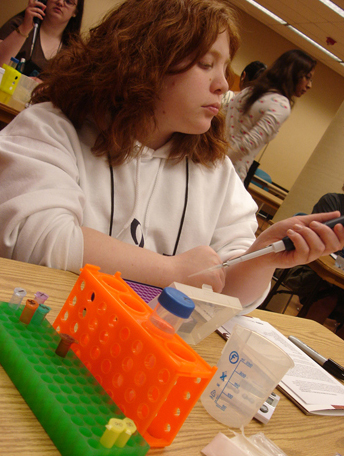
The goal of the AccessSTEM project is to increase the success of students with disabilities in completing associate, baccalaureate, and graduate degrees in science, technology, engineering, and mathematics and the number of persons with disabilities entering the STEM workforce. This goal aligns with several of the goals of the University of Washington's Office of Minority Affairs, including creating systemic change within the institution to broaden the scope of diversity and creating a more welcoming campus. The University of Washington's College of Engineering also shares the goal of increasing diversity with its student body and faculty. It is noteworthy that the University of Washington has twice the national average of female faculty in engineering.
One important component of the AccessSTEM project is the opportunity for students to participate in research internships. These internships give students a sense of community and increase their involvement and investment in the field. These internships have a positive impact on the faculty and graduate students who work with the student with a disability during an internship. One example of this benefit involves a faculty member who hosted a student with a disability in a summer research internship. The faculty member reported that she benefitted by learning how to communicate with students with a wider range of abilities and disabilities. She also reported that it was great for her graduate students to learn more about working with students with disabilities and that it encouraged them to think about different ways of doing things and working with people. These research internships give incoming students opportunities to meet and get to know faculty. They also help faculty members gain insights into making their lessons more accessible to all students.
The literature review that guided the development of the AccessSTEM project includes a publication from the National Organization on Disabilities that describes some of the barriers students with disabilities face when trying to achieve success in postsecondary education. These barriers include:
- diminished or different support systems at different academic level
- little access to successful role models
- inadequate self-advocacy skills
- a lack of access to technology that can increase independence, productivity, and participation
- inadequate accommodations
- low expectations and other negative attitudes on the part of people with whom they interact
Lessons learned from previous DO-IT projects that serve as guiding principles for AccessSTEM are:
- Increase the overall pool of college graduates with disabilities to increase STEM degrees;
- Provide motivational activities to recruit students without initial interests in STEM;
- For students with STEM interests, comprehensive interventions have more impact than isolated efforts;
- Institutional changes are critical to increase the persistence of students with disabilities in STEM.
Results from DO-IT's Longitudinal Transition Study have also influenced the development of interventions for AccessSTEM. Some of the results are highlighted below:
- Access to technology, internships, college and career planning, and mentoring activities were rated as highly valuable by 212 survey respondents.
- 95% of survey respondents had access to mentors after their involvement with DO-IT compared to only 32% who reported having access to mentors prior to their participation with DO-IT.
- Survey participants had a 100% high school completion rate as compared to 54-70% reported in the National Longitudinal Transition Study (NLTS).
- 92% of survey respondents who graduated high school attended college and 97% of those who attended college did so within two years of high school completion. The comparison data from the NLTS is that 77% of respondents had a goal of attending college, and 31% attended within two years.
- Half of all respondents who attended college attended two-year schools, which is similar to NLTS data.
- Of those respondents who attended two-year schools, 36% reported a major or minor in the natural sciences and/or engineering. Of those respondents who attended four-year schools, 45% reported a major or minor in the natural sciences and/or engineering. This is compared to a national average of 18%.
- Of those respondents who attended graduate school, 33% reported majoring in the natural sciences and/or engineering compared to 9% of all students nationally.
Other DO-IT research findings that impact project design and activities are:
- Students with mobility impairments were as likely as others to report interests and strengths in STEM, but fewer reported a STEM career goal.
- More males than females reported STEM interests, strengths, and/or career goals.
- In online communication, males were more preoccupied with the Internet and other technology and females with personal issues.
- DO-IT increased the perception of career options, particularly for girls.
- DO-IT increased interest in STEM for those not initially interested.
- Work-based learning participants reported increased motivation to work toward a career: knowledge about careers and the workplace; job-related skills; the ability to work with supervisors and coworkers; and skills in self-advocating for accommodations.
Data from the University of Washington also speaks to the impact that DO-IT has had on the campus community. Between 1991 when DO-IT activities began and 2001, the number of students with disabilities receiving STEM undergraduate and graduate degrees increased by 168% and 450%, respectively. This is in contrast to the increase of the general population of students where the increase in undergraduate and graduate STEM degrees was 43% and 37%, respectively. During this time period, there was a 133% increase in the number of undergraduate students with disabilities majoring in STEM fields and a 250% increase of graduate students with disabilities majoring in STEM. This is again in contrast to the general population of students where the increase for undergraduate and graduate STEM majors was 44% and 24% respectively. These numbers are a conservative estimate given that only about 25% of students with disabilities report their disabilities to the institution.
Reports from Small Group Discussions
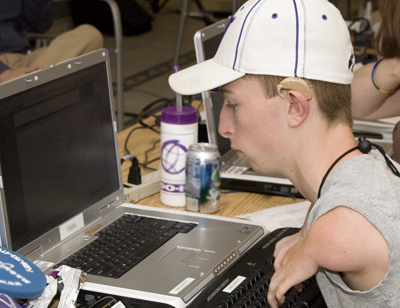
The CBI participants engaged in small groups discussions to answer the question below:
What are some specific things project partners (Seattle Public Schools, Seattle Community College, Bellevue College, and University of Washington) can do in 2009-2010 to increase the participation of students with disabilities in STEM?
Groups were asked to focus on activities that could be conducted in the spring, summer, and fall of the current project year as well as those that could be planned for subsequent years. A summary of the ideas presented follows:
- Arrange for representatives from colleges to visit high schools and talk with students with disabilities about postsecondary education;
- Collaborate with staff in the Seattle Public School system (such as the school nurse) and other vehicles (like posters or the school newspaper) to recruit students for participation in STEM activities;
- Lead career exploration events for high school students such as college transition planning workshops or field trips;
- Promote student self-advocacy through presentations to students and educators. Offer creative ways to help students practice self-identification of their disability;
- Encourage high school and college students with disabilities to participate in existing career exploration activities;
- Host college transition events several times a year on various college campuses;
- Have AccessSTEM brochures available at college disability services offices, veterans' services offices, and high school counseling offices;
- Review student data at partner colleges to locate and recruit students for the AccessSTEM Team;
- Encourage partner institutions to hire AccessSTEM Interns for projects;
- Host a disability summit at a partner college;
- Host an AccessSTEM table at spring career fairs;
- Co-sponsor or host existing events such as Math Day and Pi Day;
- Utilize service learning and cooperative education offices;
- Create and distribute flyers (both printed and electronic) for AccessSTEM activities;
- Provide a link to the AccessSTEM website from partner websites;
- Post testimonials, case studies, and biographies of successful STEM students on the AccessSTEM website;
- Host student panels that enable students with disabilities to share their experiences and break down barriers and stereotypes;
- Partner with K-12 schools to offer staff training on technology and universal design;
- Develop a work group at high schools and offer a training series on relevant, topics of interest;
- Present information on accessibility and universal design directly to Seattle Public School departments, especially in math and science subject areas;
- Offer training for high school and college guidance counselors on the specific needs of students with disabilities as they prepare for the transition to college;
- Continue to assess and improve the accessibility of partner and STEM websites.
AccessSTEM Website and Searchable Knowledge Base
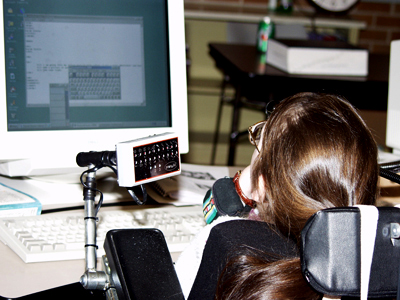
The AccessSTEM website is a space where K-12 teachers, postsecondary educators, and employers learn to make classroom and employment opportunities in STEM accessible to individuals with disabilities. It is comprised of six primary areas:
- Accommodation Strategies
How educators and employers can ensure access to academic and employment opportunities in STEM for individuals with disabilities - Knowledge Base
A searchable database of frequently asked questions, case studies, and promising practices related to how educators and employers can fully include students with disabilities in STEM activities - Presentations
Streaming video presentations with accompanying publications that share strategies for working with students with disabilities in mathematics and science classes - Resources
Resources to help instructors more fully include students with disabilities in course activities - Rights and Responsibilities
The rights and responsibilities of educators, student support staff, and students with disabilities - Universal Design
Strategies for creating academic environments that maximize the learning of students with a wide range of abilities and disabilities
DO-IT maintains a searchable database of frequently asked questions, case studies, and promising practices related to how educators and employers can fully include students with disabilities in computing activities. The Knowledge Base can be accessed by following the "Search the AccessSTEM Knowledge Base" link on the AccessSTEM website.
Individuals and organizations are encouraged to propose questions and answers, case studies, and promising practices for the Knowledge Base. In particular, the promising practices articles serve to spread the word about practices that show evidence of improving the participation of people with disabilities in STEM. Contributions and suggestions can be sent to doit@uw.edu.
Examples of Knowledge Base questions include the following:
- What lab safety issues need to be considered for a student who is deaf, has a visual impairment, or has a mobility impairment?
- Where can I find vendors who specialize in assistive technology and materials for science laboratories?
- Do fume hoods exist that are accessible to people with mobility impairments?
- How can I help a student who is blind or has low vision make measurements in a science lab?
- How can I help a student record and analyze data in a science lab?
Examples of Knowledge Base case studies and promising practices include the following:
Acknowledgements
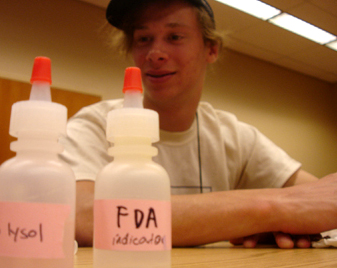
AccessSTEM Capacity Building activities are funded by the National Science Foundation (grant # HRD-0833504). They were coordinated by the Alliance for Students with Disabilities in STEM at the University of Washington, lead by the DO-IT Center. Project partners include Seattle Public Schools, Seattle Community Colleges, and Bellevue College. Any opinions, findings, and conclusions or recommendations expressed in this material are those of the authors and do not necessarily reflect the views of the National Science Foundation. [
Some content of this publication is taken with permission from the DO-IT website at www.washington.edu/doit. Permission is granted to modify and duplicate these materials for noncommercial purposes provided the source is acknowledged. Electronic versions of this publication are available in print-ready and accessible formats at www.washington.edu/doit.